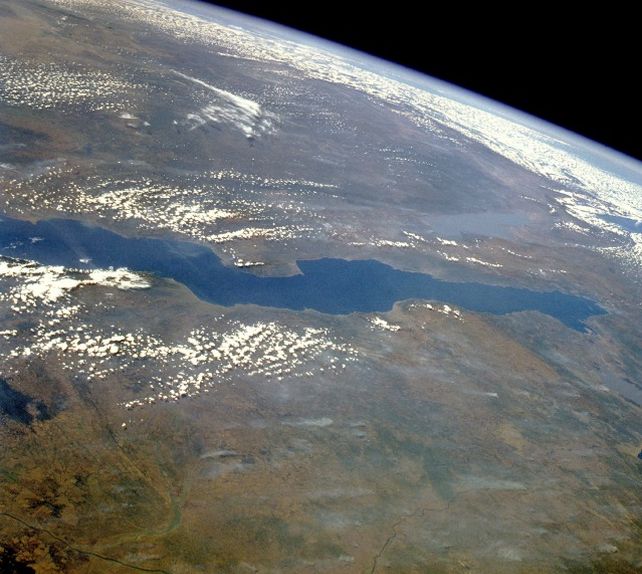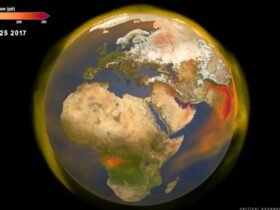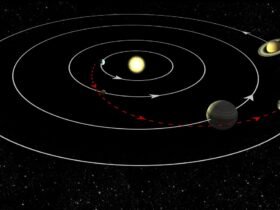If a star explodes in space and no one is around to see it, does it wreak a change on terrestrial evolution?
Yes, maybe – if you’re a microbe quietly minding your own business in Lake Tanganyika in the highlands of eastern Africa.
A new study has found that an explosion in virus diversity 2.5 million years ago in Lake Tanganyika occurred at the same time radiation from an ancient supernova bathed Earth in cosmic rays.
This could imply a link between the diversification and the cosmic radiation, according to a team led by astrophysicist Caitlyn Nojiri of the University of California Santa Cruz.
“It’s really cool to find ways in which these super distant things could impact our lives or the planet’s habitability,” Nojiri says.
Radiation is thought to be one of the contributing drivers of evolution here on Earth, a chaotic influence that pushes cells to mutate, for good or for ill (or for neutral). Evolution would happen with or without radiation; but it can play a role in nudging changes along.
frameborder=”0″ allow=”accelerometer; autoplay; clipboard-write; encrypted-media; gyroscope; picture-in-picture; web-share” referrerpolicy=”strict-origin-when-cross-origin” allowfullscreen>
The Solar System sits in a bubble in space known as the Local Bubble, a region relatively devoid of other stars. Astronomers believe that this bubble was carved out by a series of supernova explosions, millions of years ago.
Since nearby supernovas can boost the radiation levels experienced by Earth by several orders of magnitude, it’s reasonable to explore the possibility that this radiation affected life on the surface.
The work of Nojiri and her colleagues involved core samples of deep-sea sediments, preserving a record of deposition over millions of years. In particular, they were looking at a radioactive isotope of iron called iron-60, which is forged during supernova explosions, and rains down on Earth in greater quantities when we travel through remnant clouds of supernova detritus.
Back in 2016, a team of physicists published a paper in which they described the identification of two spikes in iron-60 in seafloor sediments. Because iron-60 has a known half-life, these spikes could be dated with a high level of accuracy – one to around 6.5–8.7 million years ago, the other to around 1.5–3.2 million years ago.
Nojiri’s team wanted to trace these spikes to specific events, so they set about ‘rewinding’ the motions of objects in local space. Their results show that the earlier spike in iron-60 occurred when Earth entered the Local Bubble, passing through the boundary region rich in the isotope from previous supernova explosions.

The latter spike, they found, was likely the result of a supernova explosion nearby between 2 million and 3 million years ago, either from the Scorpius-Centaurus group of young stars some 460 light-years away, or the Tucana-Horologium group 230 light-years away.
A supernova remnant and associated runaway stars in Scorpius-Centaurus – one of the latter being a pulsar, the collapsed core of a dead star after a supernova – suggests that this region is the most likely of the two to be the culprit. Indeed, a 2019 study already linked the iron-60 spike to this very supernova event.
The team performed simulations to find out how this explosion would have affected Earth – aside from the iron-60 spike, that is. They found that our planet would have been bombarded with powerful cosmic radiation for around 100,000 years in the wake of the supernova.
frameborder=”0″ allow=”accelerometer; autoplay; clipboard-write; encrypted-media; gyroscope; picture-in-picture; web-share” referrerpolicy=”strict-origin-when-cross-origin” allowfullscreen>
If the explosion took place in Scorpius-Centaurus, the dose could have been an additional 30 milligrays per year during the first 10,000 years; for Tucana-Horologium, the dose would have been 100 milligrays.
Either way, there may have been effects. A 2016 paper describing research conducted in India found that the radiation threshold for breaking DNA may be around 5 milligrays per year.
While there’s no direct line drawn between the two events, a paper last year found a startling increase in diversity of fish viruses in Lake Tanganyika between 2 and 3 million years ago.
“We can’t say that they are connected, but they have a similar timeframe,” Nojiri says. “We thought it was interesting that there was an increased diversification in the viruses.”
At the very least, the research suggests that there may be a link between wild events in the cosmos, and the trajectory of evolution here on Earth. We may say that we exist in a bubble in a vacuum, but truthfully, all things can affect other things. Or, as Carl Sagan famously once said, we are all stardust.
Maybe we should think about that more than we do.
The team’s research has been published in The Astrophysical Journal Letters.













Leave a Reply